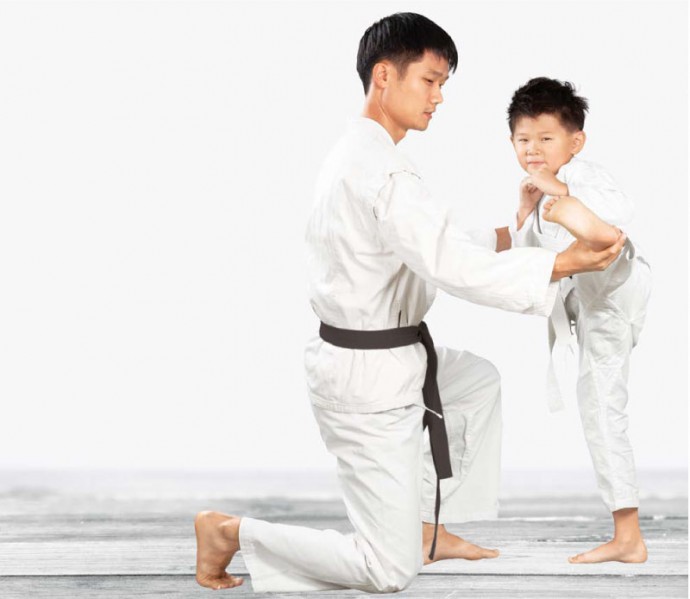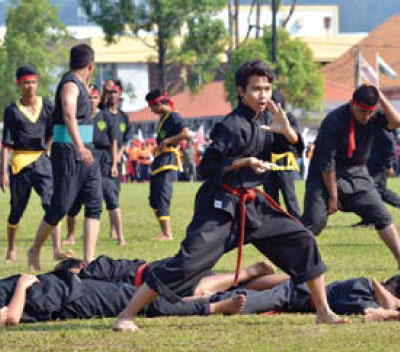Martial arts are an excellent method for your child to build up his fitness, self-discipline and his socialisation skills. A good age to start is by seven years old as he should have more than enough muscle and motor skill control to handle all the necessary techniques that he will learn.
Still not convinced that martial arts bears great benefits? Here are six reasons to learn martial arts:
- Builds him up – one of the core values inherent in all forms of martial arts is their focus on self-discipline. It is also a great way to boost your child’s self-confidence and self-esteem. He will also learn the virtues of humility and be taught not to misuse or abuse his training. Those ‘tough guy’ characters belong in movies, not in the real world and every martial artist ultimately learns to respect his fellow humans and true humility which stems from his own confidence in his abilities.
- Great physical & social activity – with the alarming problem of childhood obesity, martial arts offers him an alternative to be active in sporting activities and is an excellent way for him to get his extra dose of physical activity. It also provides him with plenty of opportunities to socialise with other children of various ages. It is known that executive functions such as selfcontrol, working memory, cognitive flexibility, focused attention, and creative problem-solving are better among those are physically active.
- Setting and achieving goals – Most martial arts measure the competence and capabilities of the practitioner based on a ranking system of coloured belts that signifies the wearer’s mastery level. This allows your child to learn how to set and reach his goals as he works toward achieving each new ranking with different colour belt. Upon achieving, the child will have confidence and feel the joy.
- Learning to take instructions – part of the challenge of mastering any martial art lies in being able to correctly grasp the technical skills that are being taught to him. This means that he will have to learn how to pay attention by listening to the instructor or coach.
- Learning to take instructions – part of the challenge of mastering any martial art lies in being able to correctly grasp the technical skills that are being taught to him. This means that he will have to learn how to pay attention by listening to the instructor or coach.
- Learn to roll with it – learning martial arts involves more than just learning how to hit things (or other people). The other half of the equation involves taking blows, which can come in the form of actual hits during training (you cannot learn how to hit without learning how to block or defence). This helps teach resilience which is necessary for your child to learn how to get back on his feet. Learning to roll with it early will also help him to respond better in his martial arts class and in life.
Martial arts in Malaysia
The next step would involve selecting a martial arts school for your child. There are numerous options available which encompasses various martial arts from different parts of the world. You may want to opt for a local flavour by searching for a local silat master for your child to learn from. Alternatively, you may want him to learn karate or taekwondo instead. Then there’s BJJ (or Brazilian Jiu-Jitsu), wushu, silambam, capoeira, aikido, judo, and even muay-thai.
These are the older and more established forms of martial arts; newer ‘versions’ such as kickboxing and MMA (Mixed Martial Arts) also exist, but they tend to cater more to the physical aspects of martial arts, i.e. the actual fighting techniques themselves.
Do note that the availability of training centres for some martial arts may be difficult to find, such as Shaolin kungfu, so you may want to shortlist two or three different martial arts rather than selecting only one.
Once you and your child have decided on which martial art to start learning, it is time to find out where to go for martial arts classes. You can ask around your community, friends, family, or even his school (many schools will have a silat, karate, or taekwondo club).
After you have found a place where he can learn martial arts, the next move is to sign him up for classes. Some places may allow your child to try out one or two classes for free, but this is not a standard practice. Upon signing up for classes, you will most likely be asked to drop off your child and not hang around during the class – this is normal, so do not worry about it. Your child needs to learn to mix around with fellow martial art friends and build-up self-confidence characters too.
When to start
While there is no ‘best time to start martial arts’, it is better to start your child at no younger than seven. Some martial arts schools will accept younger children, but it will be entirely at their discretion. The main point here is to get your child moving and focused. You can do your part by ‘interviewing’ the instructor when you approach him or her to ask for more information. A good instructor will have a sense of purpose and be able to impart both the drive and discipline to his or her students.










Comments